The work equalises the emotions, and enables the two submerged to surface in series of unpredictable configurations. Work is the constant carnival; words, the rhythm and pace of two, who mine undeveloped seams of the earth and share the treasure.1
—Gillian Rose
In an essay by Noura Wedell on “radical educator” Fernand Deligny’s experiments on children suffering from “deep encephalopathy,” or severe autism, in the 1960s, Wedell writes that Deligny wanted to offer the children “a place outside of the institution” where, instead of being conditioned through restrictions and reprimands, they were set free to “fuck up.”2 Screaming if they had to, or holding onto objects for attachment—not use—the children would be “freed from being only what they were for those who would ascribe some fixed purpose to them.”3 The wildness was facilitated, encouraged: their bodies left wholly separate from society’s intentions for them. By mirroring the actions of adults, the children would necessarily absorb certain functional behaviors, but it was not assumed or taught as essential for action—or being. Instead, Deligny’s interest lay in how the children developed a sense of the common through their environment, which is to say through the area they occupied and how they interacted with it materially. As their movements were diagrammed in seemingly chaotic yet consistent drawings, patterns appeared, suggesting that the children’s minds followed an innate “choreography.” Unable to express themselves in speech, the children formed a language that appeared on paper as loops around areas they felt attached to. The children never wandered outside these perimeters, and would often stall in single spots that had been marked, at times violently, by elements they could recognize, such as a place where there had been a fire in the past.4 This “habitat,” as inscribed by the daily life of its occupants, provided an immediate psychological shelter, but moreover crystallized a mode of expression situated in the senses, in proximity to others, and in associations with space.
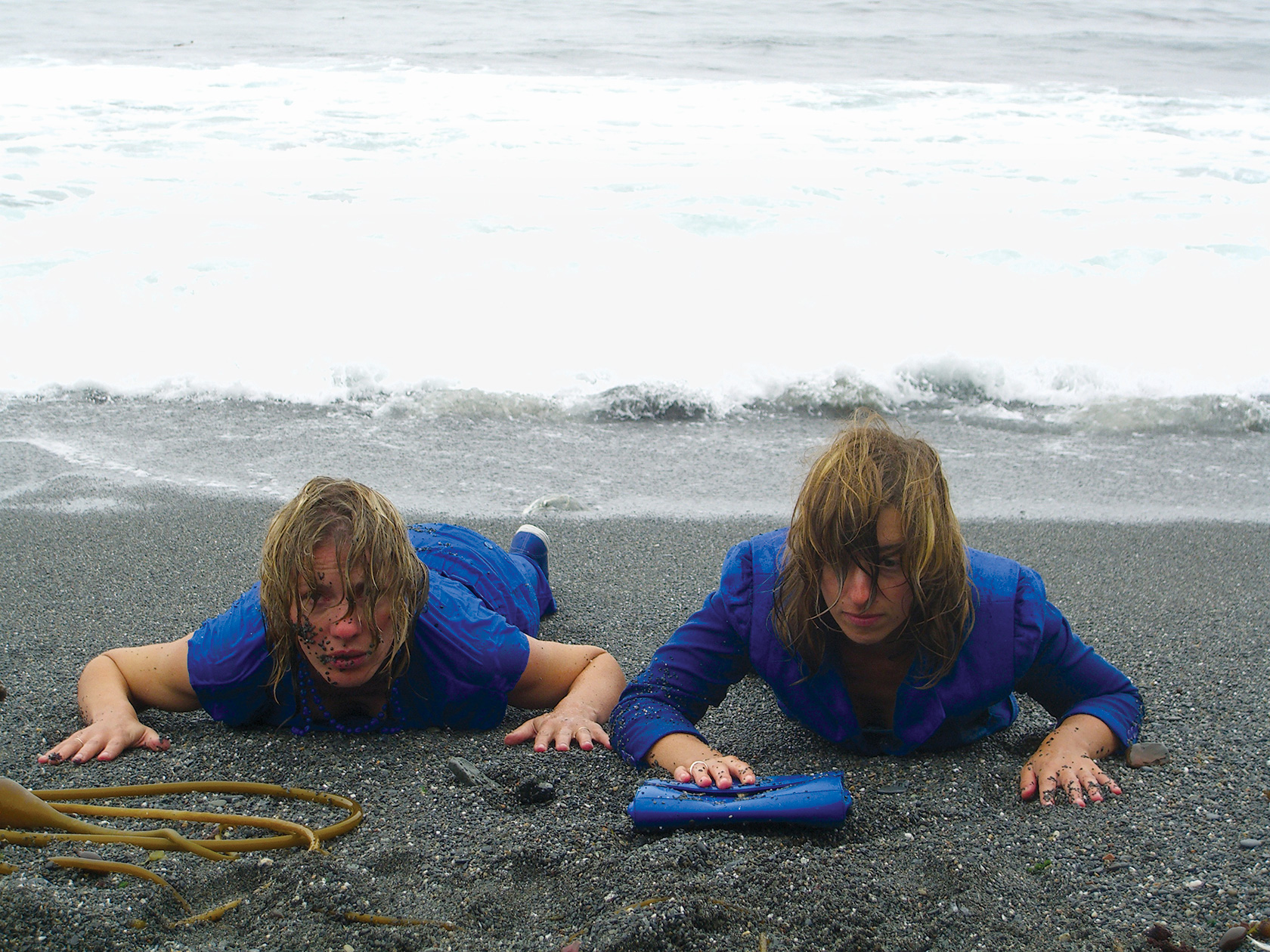
A.L. Steiner, Untitled (blue), 2007. Color pigment print, from C.L.U.E., Part I (color location ultimate experience), by A.L. Steiner and robbinschilds, digital video, 2007. Courtesy the artists and Koenig & Clinton, New York.
At the beginning of the video C.L.U.E. (color location ultimate experience) (2007),5 by A.L. Steiner and robbinschilds (Sonya Robbins and Layla Childs), two women flop onto a beach wearing outfits composed singularly of shades of blue. This flop is the departure point for a slow procession of open-ended choreography in which the two dancers in shifting colors of costume move through various outdoor settings, from deserts to urban rooftops. In various hues, the dancers—Robbins and Childs—devise a body language that signals through release, plummeting, slumping, falling, and floating. The dancers strive to articulate affect through common movements, which are mirrored yet ever so slightly out of sync. This slight awkwardness articulates inexperience, which, as the video progresses, develops into a speechless language of twirls, spins, falls, and collapses. As precursors for the spectrum that follows, the moves can be interpreted as a way to imagine subsisting on the other side of speech. Accentuated by sky blue outfits, the choreography in the first scene is, as Gertrude Stein would have it, precocious.6 It empties, calms, and neutralizes only to embody communication in common gesture.
Entering the frame as though evolving from the sea, the pair is made primordial: floppy and emergent, they squirm on the sand in unison. Shoes set aside, they begin a dance awkward enough to seem either ill-rehearsed or partly hashed out; the movements change in each sequence, suggesting cyclicality with no apparent end. In this interstitial zone—neither civilization nor the wild—there’s no hurry. Maybe, to be barefoot (especially while primly clad in pearls and a pencil skirt) is to be on the brink of wildness, in an attempt to become feral. But to write of wildness is to undermine and contain it; as Jack Halberstam has noted, “Wildness cannot speak without producing the…order that gives it meaning.”7 Instead, let’s call it the semi-wild. Like a tourism video promoting love’s work, C.L.U.E. is an ideal place where the self can take a break from definition and dwell in its own matter. Propelled by their open-ended choreography, the women travel through unspecified parts of the country. They pause by mountains and Home Depots, concrete plazas and grassy knolls, exploring their organized freedom, matching each shifting landscape with a new outfit and another set of twinned motions. The dancers exist on a messy and spirited spectrum: with each change of location comes a change of clothes, each outfit color-coded in monochromes constituted of minor variations in hue.
Two people heading decisively in one direction, apparently without destination, the dancers map each landscape in awkward and slightly uncoordinated movements. Their gestures echo the mental maps drawn from the children’s motions in Deligny’s research. The choreographies constitute a language affixed to space; their rhythmic pace crystallizes an alternative to the claustrophobic encapsulation of the spoken or written word. The dancers step into the world only to step outside of its social prescriptions.

A.L. Steiner, Untitled (magenta), 2007. Color pigment print, from C.L.U.E., Part I (color location ultimate experience), by A.L. Steiner and robbinschilds, digital video, 2007. Courtesy the artists and Koenig & Clinton, New York.
As the title suggests, the “ultimate experience” requires looking elsewhere, going out of bounds—and doing so for the sake of re-energizing socialization as an embodied, affective process. Grasping payphones on a dark street corner, yet not speaking into them, falling off a display bed in a furniture store, and skipping in a circle holding seemingly empty, disposable coffee cups all feel emblematic of behavioral learning; the choreography becomes an absurd pedagogy to inspire a makeshift wildness.
The colors of the varied and mismatched garments act as interlocutors, translating between the dancers’ bodies and their scenic locations. They find common ground in hues that consolidate affect, such as a bright fuchsia that animates the dancers’ spirits just as the video picks up pace, and an aquatic blue worn by the women while they float face down in a pool, as though holding their breath to see how long they can last within what lies beneath. However imprecise such language may be, the palette, which is in the range of a basic eight-color box of crayons, invokes LGBTQ politics. Steiner, whose work has generally found its locus in the discourse surrounding identity and sexuality, plays with the basic symbolism of the rainbow as a way to access a more complex spectrum. Their movements, semi-wild and carnivalesque, visualize a freedom—from or of speech—sought after by those who feel marginalized or voiceless under the social codes underlying dominant culture. Within the video, each of the colors is formed from constituent hues, creating minor but palpable differences within the outfits. It is an apt metaphor for the sliding spectrum of sexuality, which is continuously essentialized by models that compress idiosyncrasies into easily digestible formats. This is to say, sexuality is extant in differentiating degrees, yet its presence in the public is all too often constricted by limited expressions.
The scope of emotions, movements, colors, and places in C.L.U.E. form a conceptual structure that speaks to this complexity; the video visualizes the spectrum not as a sequence of clearly delineated colors but rather as overlapping nuanced hues. It collapses the range of identification (the women clad in a band of colors) with the embodied, active language of the choreography, which is akin to the physical articulations of those who suffer from extreme difficulties in communication. Both color and movement are expressed as varied and shifting. Instead of marginalizing, they work in tandem toward a freedom from confining social codes. The choreography suggests a socialization based in communities that acknowledge the affective relationship between bodies and space. Identification, at that, is often constructed in relation to an “other” and is commonly manifest in external signifiers, such as clothing, hairstyle, make-up, behavior, gestures, and ways of speaking. Combining these facets, C.L.U.E. draws an awkward parallel between color and the location of identity, as though dancing around a fixed point could express one’s place on the spectrum, and the color one landed on or, in this case, put on, could incite an affective communicative structure.

A.L. Steiner, Untitled (orange), 2007. Color pigment print, from C.L.U.E., Part I (color location ultimate experience), by A.L. Steiner and robbinschilds, digital video, 2007. Courtesy the artists and Koenig & Clinton, New York.
The women’s escape to the semi-wild is thus an experiment in color-coding: a trip outside universalism that visualizes difference paradoxically by creating minor variances in color and choreography. It is as though the women predetermined the color palette for each scene—highway as fuchsia, dusty sand hills as green—yet each showed up with her own interpretation of these colors. The varying landscapes echo this idiosyncrasy by contrasting the dancers’ attempts to cohere against varying backdrops. The radical scenic changes highlight the dancers’ minor differences. In one sequence, the women, clad head-to-toe in red (crimson, rose, scarlet) hash out something unspoken through humorously argumentative gestures that resemble a fistfight in a low budget sci-fi film or a lovers’ quarrel reenacted from a rom-com. Their corner store hangout seems out of place, enhancing the video’s narrative intrigue. In another scene, they stand in front of a John Chamberlain-esque heap of crushed cars, waving their bodies—clad in white—like flags, resigning to the pure pleasure of new-found freedom. Colors and contexts crash and collide, demolishing discourse.
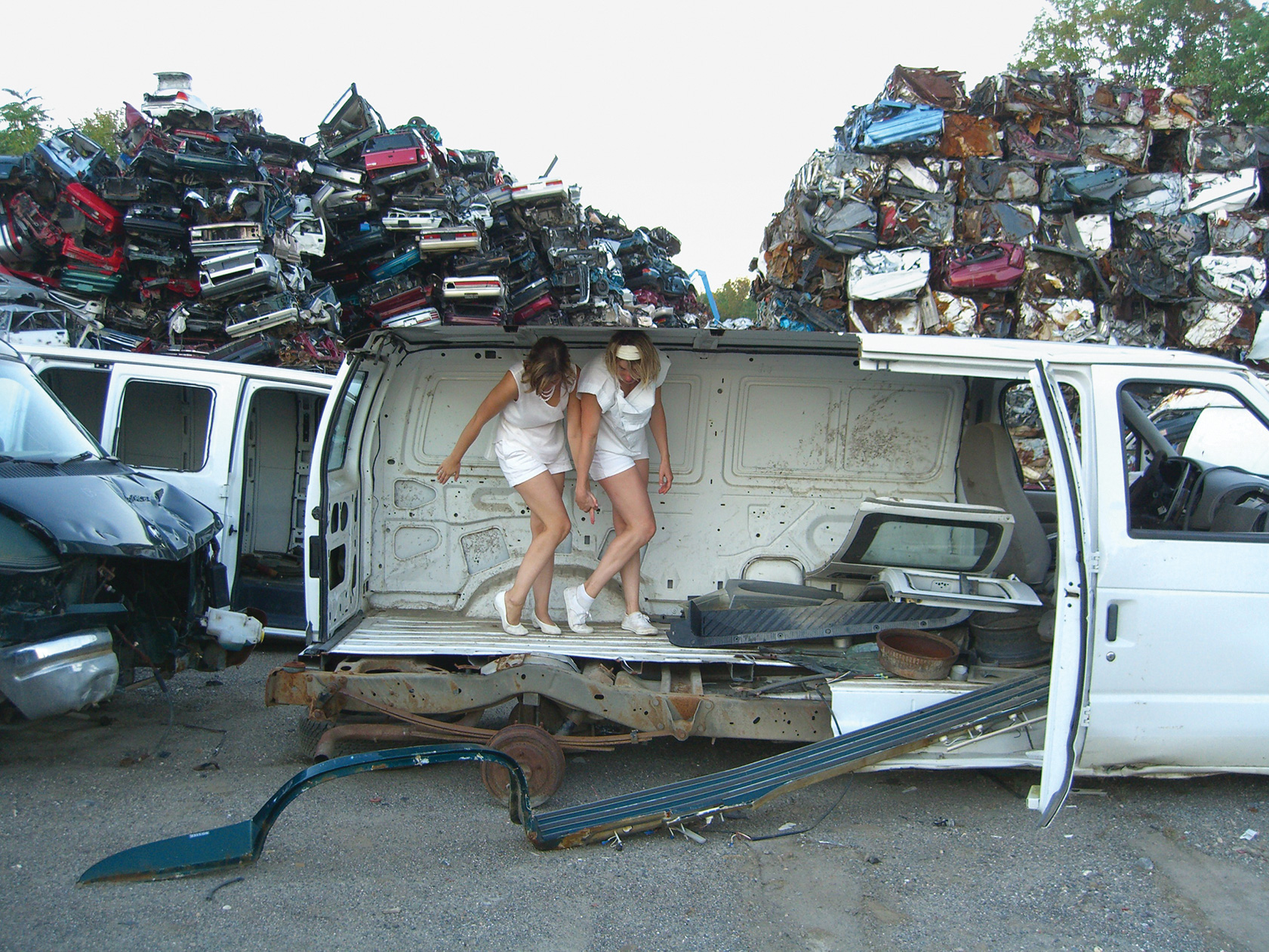
A.L. Steiner, Untitled (white), 2007. Color pigment print, from C.L.U.E., Part I (color location ultimate experience), by A.L. Steiner and robbinschilds, digital video, 2007. Courtesy the artists and Koenig & Clinton, New York.
Although it would seem paradoxical to introduce prescriptive structures into the realm of wildness, formalism is implicit in all this. However unpremeditated the dances appear, their choreography adheres to a history of experimental dance. Experience, not to mention the question of identification, is enacted through simple movements that push not only the concept but also the pace and tone of the video. At base, the video progresses through this dance, which is then emphasized and mannered by the colors and environs. It contextualizes the subjectivities of both women, even if they differ in costume, vary in hue, and are often out of step or bouncing in opposite directions. One falls, the other watches; one turns, the other observes and follows suit. The motions reflect the doomy, melodic soundtrack by Seattle-based alt rock band Kinski, which picks up pace as the dancers hop around an empty highway or animatedly gesture with their hands against a mountain landscape. Elsewhere, the sounds match the pair’s more minimal moves, simple shifts like falling or rolling. In fact, falling starts to become formulaic in the film—the two women drop down in various sites as though having figured out how freeing it is, how fun, how crucial to be made speechless. (“Falling forever, going to pieces,” writes Maggie Nelson.)8 The intractable motions are both cyclical and eddying; the dancers match each other’s moods on tiptoes, holding hands, lying down. The minor differences in their pace and body language exacerbate the haphazard, sporadic qualities of the choreography. However, aligned with how the compositions of color and outfit function throughout the film, it seems a calculated choice to visualize certain desire lines and to speak of idiosyncrasy.9 By gesturing toward difference, the women put themselves in a “position of liminality, in that productive space of the construction of culture as difference, in the spirit of alterity or otherness,” to quote Homi K. Bhabha.10 The dance, formally elemental, expresses this otherness like a faux-pas-de-deux.
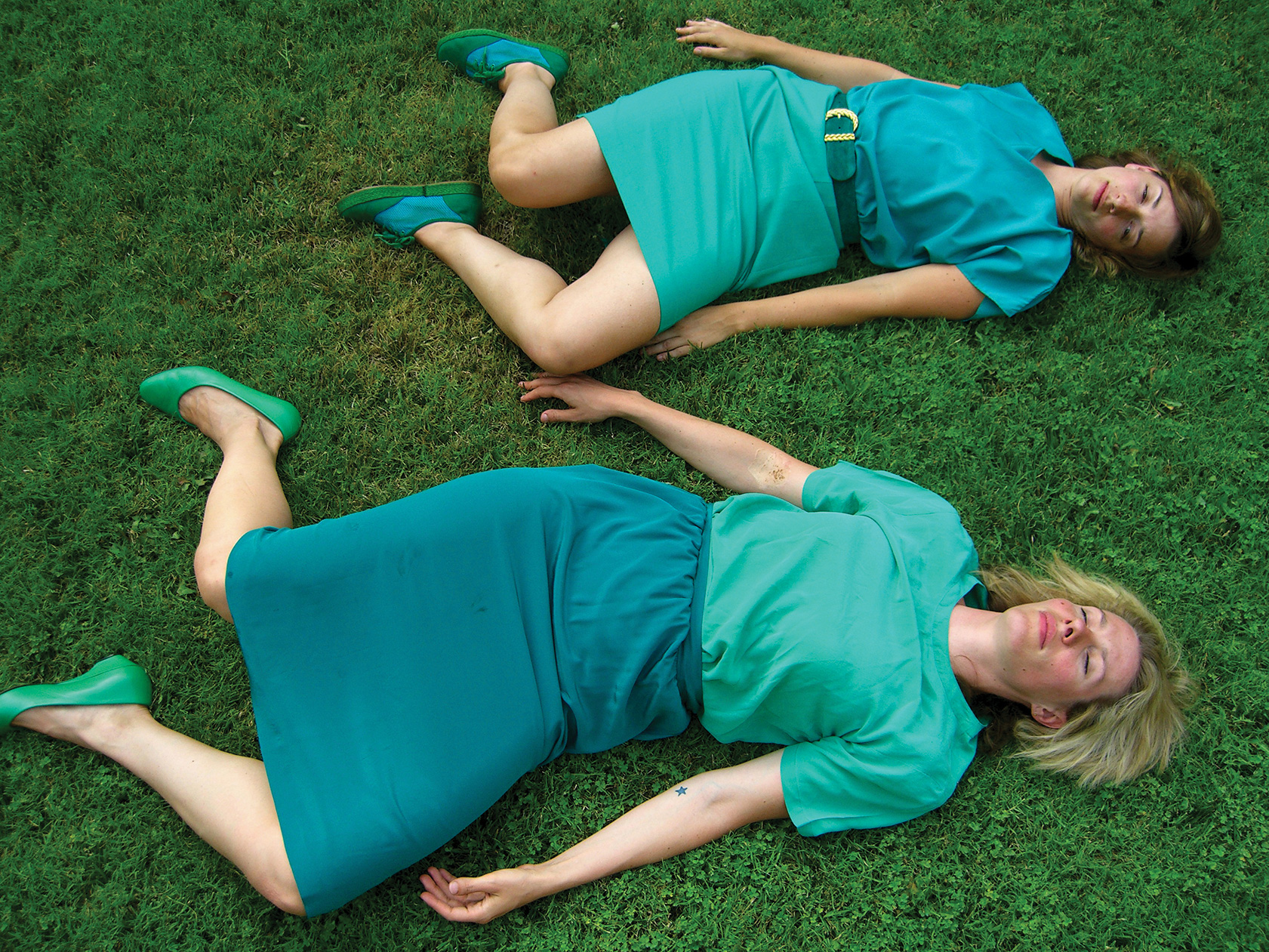
A.L. Steiner, Untitled (green), 2007. Color pigment print, from C.L.U.E., Part I (color location ultimate experience), by A.L. Steiner and robbinschilds, digital video, 2007. Courtesy the artists and Koenig & Clinton, New York.
Repeatedly, the dancers match each other’s moods through color and motion, but also in the composition of their outfits, which is the most differential element of the video. While one is in pants, the other sports an over-the-knee skirt; one in Barbie-pink knickers and a fuchsia blouse, the other in a Barbie-pink skirt and fuchsia knickers. These amount to correspondences between the dancers independent of their actions, gestures, or speech. They mirror and mimic through clothing and motion, in shades that return the favor of emotion rather than claim authority over it. It’s a way of layering experience, as though the separation between body and affect could be clearly pronounced or formalized. It is, in this sense, beyond language: put together in a place where there is no sense but of an “other,” and where, as Noura Wedell suggests, “the ‘we’ pre-exists our cohering into subjects and is still ‘pre-individual.’”11 That “we,” in this case, comes forth in color and tailoring, as an empathetic relationship that mismatches, paradoxically, to create stronger cohesion.

A.L. Steiner, Untitled (magenta), 2007. Color pigment print, from C.L.U.E., Part I (color location ultimate experience), by A.L. Steiner and robbinschilds, digital video, 2007. Courtesy the artists and Koenig & Clinton, New York.
I wonder if C.L.U.E.’s dancers affix on their locations to similar ends. With no actual way “out” of language, their restless travels inscribe affect on trodden ground, whether grassy knolls, concrete plazas, or, by extension, the galleries where the video has screened and, in some cases, been reenacted as a live performance. Since its premiere,12the jouissance of Steiner and robbinschilds’ rainbow has unhooked itself from the expected tropes of political art, as it eschews its infernal didactics to veer into the arena of play. Here, liberation is not posed as a radical concept: it is simply the result of stepping outside of exchangeability and letting another set of faculties—sensory, material, affective—move you. Usually a rhythm will emerge. As Gillian Rose writes in Love’s Work, “It cures, folly by folly.”13This dance is childishly simple, but it facilitates a kind of freedom.
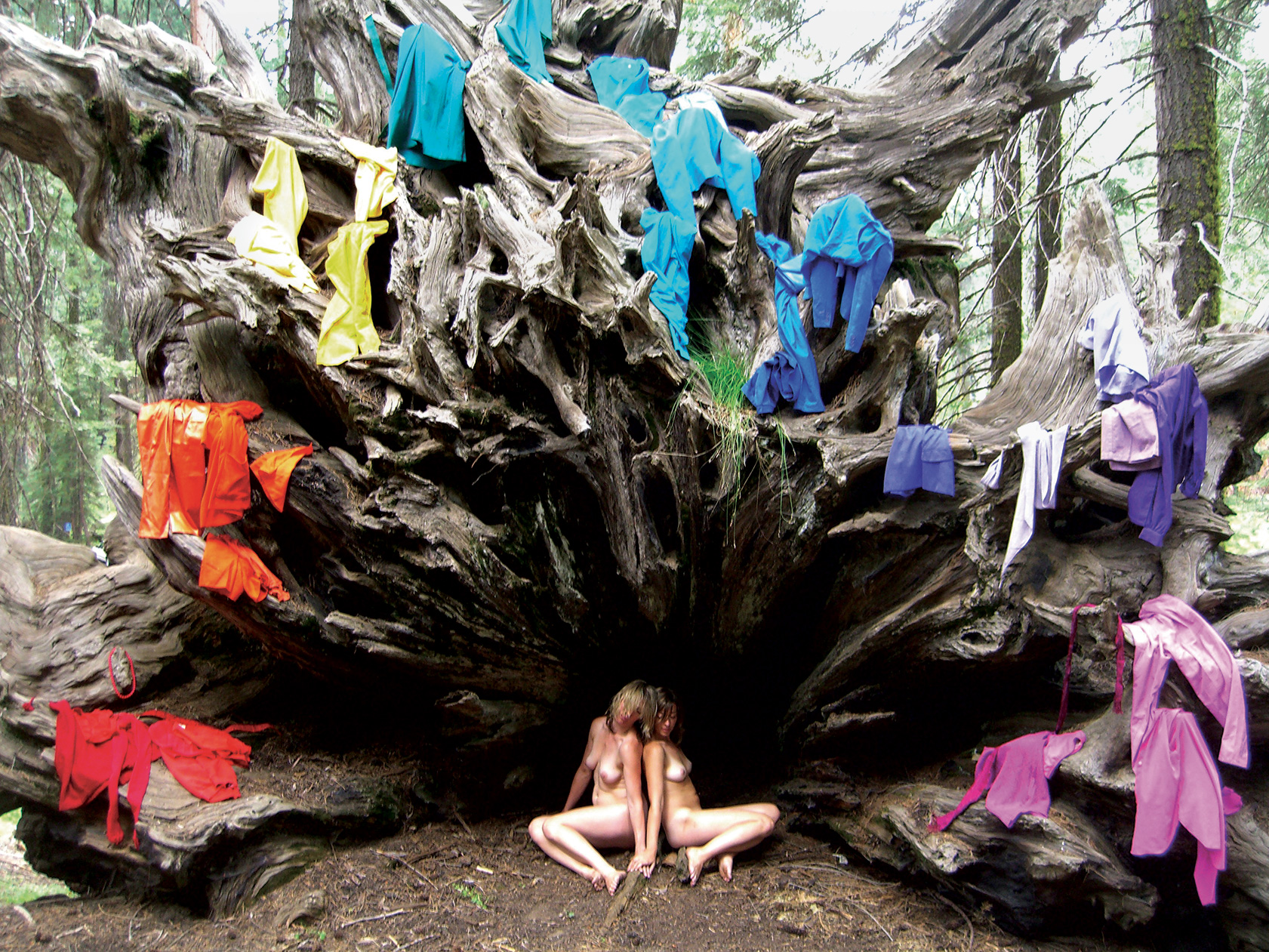
A.L. Steiner, Untitled (rainbow), 2007. Color pigment print, from C.L.U.E., Part I (color location ultimate experience), by A.L. Steiner and robbinschilds, digital video, 2007. Courtesy the artists and Koenig & Clinton, New York.
As the video reaches its climax, the two women crawl naked around a forest floor as though featured in an SNL parody of a Lars von Trier film. A rainbow of clothes, in a broken spectrum, hangs loosely around a large tree. More than a little cringe inducing, the ending leaves me wondering what is gained by pushing the rainbow to the point of cliché. What do these colors, when placed into proximity with one another, leave us to consider? What can they tell us about the emotional spectrum that surfaces, invisibly, when experience is essentialized as a common choreography? The refusal to speak or stay put is here linked to a desire to disentangle from the private individual, as though feeling or identifying en masse, collectively, even as a duo, is the only way to feel grounded. Despite the constant relocations, the choreography visualizes a self shaped by similar methods of identification that are rooted not only in attachments to color and mirroring garb but also in specific places that are felt and explored together. Though I am wary of romanticizing autism, which is certainly a much more complex experience than can be considered in this context, the spatial attachments described by Wedell encroach on a portentously naturalistic or romantic theory of the commons. Wedell proposes two types of freedom: one is found in differential formal correlations as expressions that venture “outside” of language; another results when we “act without any wanting at all.”14 The latter pertains to a freedom found when our prescriptions can be “shaken off,” which is to say when we move, dress, or express ourselves without a clear goal. This does not exclude desire, nor does it eschew signaling one’s identity through such behaviors and characteristics. Rather, it points to the potential inherent when such identifications are given space. The women rid themselves of societal expectations, which, for example, advocate linearity, going from A to B with intent, dressing for success, and ending up in prescribed (often patriarchal) states of being. Boundless desire, or desire without function, could be applied as an ethos for robbinschilds and Steiner’s road trip, where the driving force is simply a desire to mobilize an affective reality. The present moment and the movements that draw two people together simultaneously set them apart. They create desire lines that map and diagram new spaces, relations, and subjectivities. For the trio, it becomes an oblique and romantic pedagogy: a way to understand how emotion pushes its own grand narrative, like a Walter Benjamin-ian love affair, where one is amorously open to a complex, material experience of the world beyond its stagnant frame.
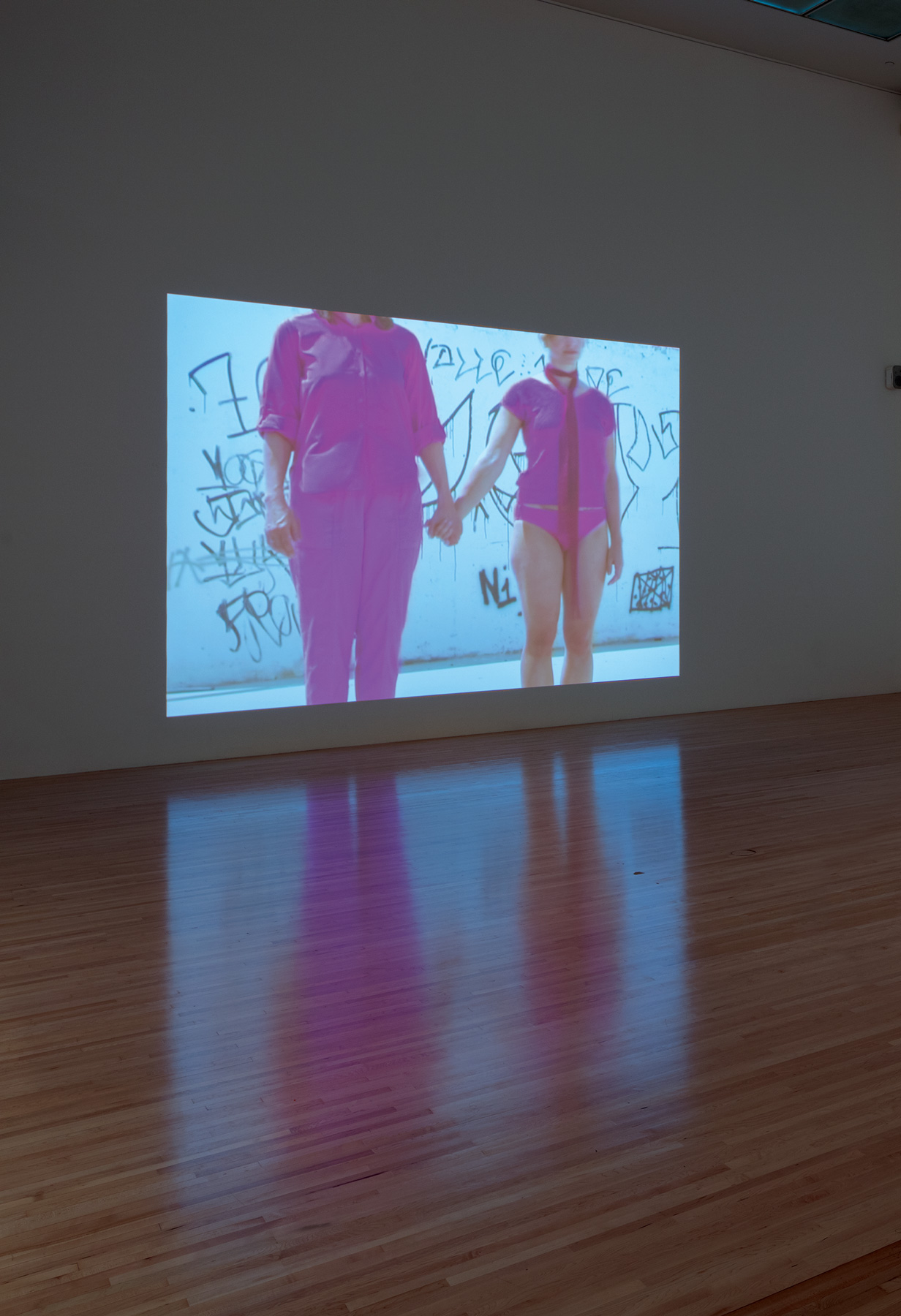
A.L. Steiner + robbinschilds, C.L.U.E., Part I (color location ultimate experience), 2007. Installation view in The Art of Our Time at the Museum of Contemporary Art, Los Angeles, August 29, 20 15–September 1 2, 201 6. Image courtesy of The Museum of Contemporary Art, Los Angeles. Photo: Fredrik Nilsen.
Sabrina Tarasoff is a Finnish writer who divides her time between Paris and Los Angeles. Together with Naoki Sutter-Shudo, she co-runs the loosely Los Angeles-based space Bel Ami.
